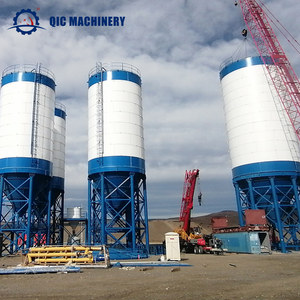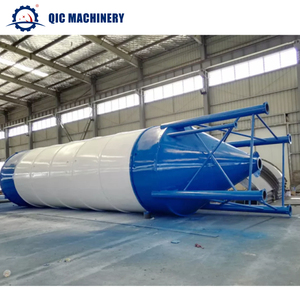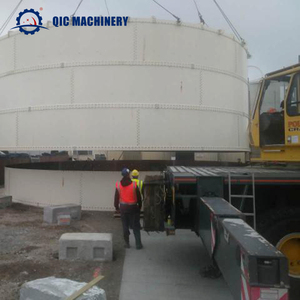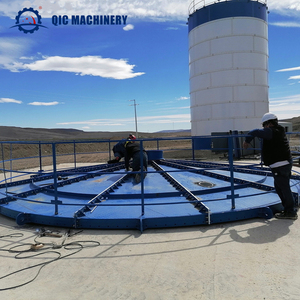(113 products available)











































































































































































































































The main purpose of a cement silo is to preserve the quality of its content, which creates the need for the suitable external environment. That's why 20000 tons cement silos come in different kinds, including flat bottom silos, trapezoidal silos, and hopper bottom silos.
Traditional silos (cement)], [Cement silo ]
Usually made of reinforced concrete, the flat-bottom silos have a wide cylindrical body with a flat base. This design enables efficient storage management and easy access for maintenance and cleaning.
Flat-bottom silos are particularly well-suited for large-scale construction projects and cement plants due to their capacity for high-volume storage and ability to maintain consistent inventory levels.
Trapezoidal silos
The trapezoidal silos have a trapezoidal shape and look quite similar to traditional silos. They have smaller tops compared to their bottoms. In some places where limited space is available for horizontal expansion, the trapezoidal silos become a practical option. In such situations, a larger capacity can be achieved by increasing height.
Hopper bottom silos
The hopper bottom silos feature a conical or pyramidal skirt at the base of the silo. This unique design facilitates the discharge of stored materials through gravitational flow. The hopper shape allows for controlled and efficient segregation of cement or other additives. Additionally, it minimizes the risk of material clumping or bridging within the silo.
Cement hoppers are ideal for projects requiring precise dosing and constant material flow, making them suitable for ready-mix concrete plants and high-volume construction areas.
Cement silos, including the 20000-ton ones, are primarily used to store bulk powder materials such as cement, fly ash, mineral powder, and other powders. They are widely used in the following scenarios.
Construction industry
Cement silos, including the 20000-ton ones, play a vital role in storing and supplying cement and other dry bulk powders for concrete production. As the cement storage facility on concrete batching plants, cement silos supply a stable and uninterrupted cement supply for the concrete plants, which in turn ensures the uninterrupted production of high-quality concrete to meet the concrete's engineering needs. Moreover, in consideration of the space limitations or production needs of certain projects, 20000-ton cement silos can also be used as a mobile cement supply system, which can provide cement for multiple construction sites at the same time.
Infrastructure projects
Cement silos are essential in large-scale infrastructure projects such as highways, railways, bridges, tunnels, and municipal projects. These projects often require a massive amount of concrete, and the capacity and stability of the cement silo are crucial to ensuring the smooth progress of the project.
Cement production enterprises
Cement plants are the primary production and supply sources for cement, and cement silos are significant storage and supply facilities. Cement silos can store finished cement for later sale and supply or store raw material cement for subsequent production.
Precast concrete plants
Precast concrete plants are manufacturing facilities for various precast concrete products such as concrete walls, slabs, beams, and pipes. Cement silos provide a sources of cement and other additives, ensuring a continuous and stable supply of raw materials for the production of precast concrete products. This guarantees the precinct concrete plants' efficiency and the product's quality.
Asphalt concrete mixing plants
Cement is an essential ingredient in asphalt concrete, and cement silos serve as storage and supply facilities for cement and other additives. The silos ensure the stability and continuity of the raw material supply for asphalt concrete mixing, thus meeting the quality and performance requirements of the project.
When purchasing a cement silo for sale, buyers look for the appropriate capacity that satisfies their construction needs. Many buyers prefer silos with capacities of 20,000 tons because they can store a lot of cement. Volume and horizontal silos are the two types of 20,000-ton silos available.
Cement Silo in Volume
Cement Silo in Horizont
Customers often prefer the volume-type silo because it is lighter and easier to move. Additionally, it can store the most cement even though it takes up little floor space. A horizontal silo has its own benefits. It is a better option for customers who have a small worksite with more horizontal space. According to the building projects, buyers can get the horizontal or volume-type silo from the supplier.
Q1: How to prevent cement from getting stuck inside the silo?
A1: The best way to avoid cement sticking inside the silo is to put aeration pads in particular places within the structure. These pads come oblinked and can be put on the inner bottom of the silo in an oblinked pattern. When they are put this way, there will be an even distribution of air flow, which can help mobilize the cement.
Q2: What are the loading and discharging methods of cement silo?
A2: For a horizontal cement silo, the loading is usually done from the top and the discharging is done from the bottom. In some cases, there can also be some openings at the sides for additional discharging. For vertical ones, they are usually top-loaded, and the discharging is done from the bottom or through side openings.
Q3: How many bags of cement can a silo hold?
A3: This depends on the silo's capacity. A 50-ton silo can hold approximately 1,200 bags of cement. A 100-ton silo can hold about 2,400 bags. A 200-ton silo can hold about 4,800 bags. It's essential to note that the quantity may vary based on the specific silo design and how closely the cement is packed.
Q4: How does a cement silo unload?
A4: The cement silo unloads by a bottom discharge system. This system has a feeder, a gate, and a dust collection system. While the feeder provides the amount of cement required, the gate controls the flow. The dust collection system then takes care of the airborne particles, making the whole process safe and clean.